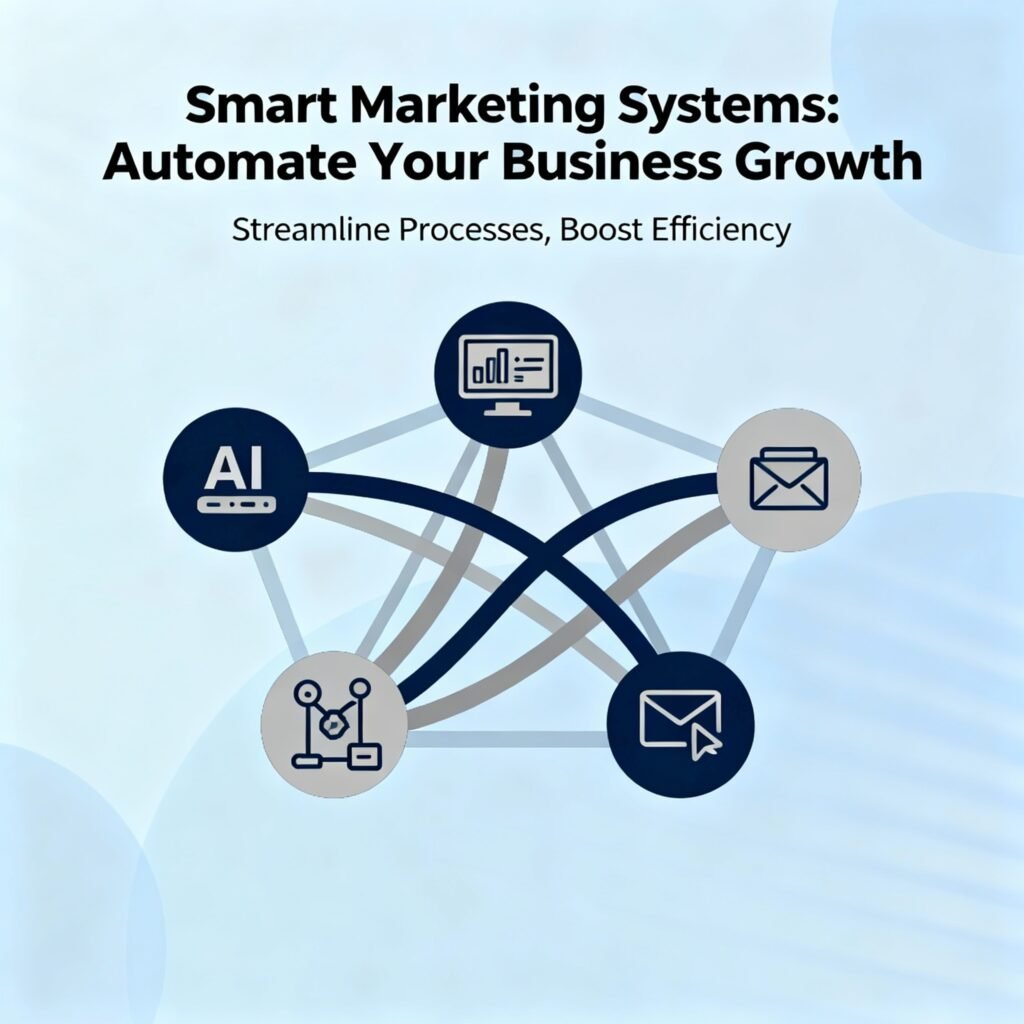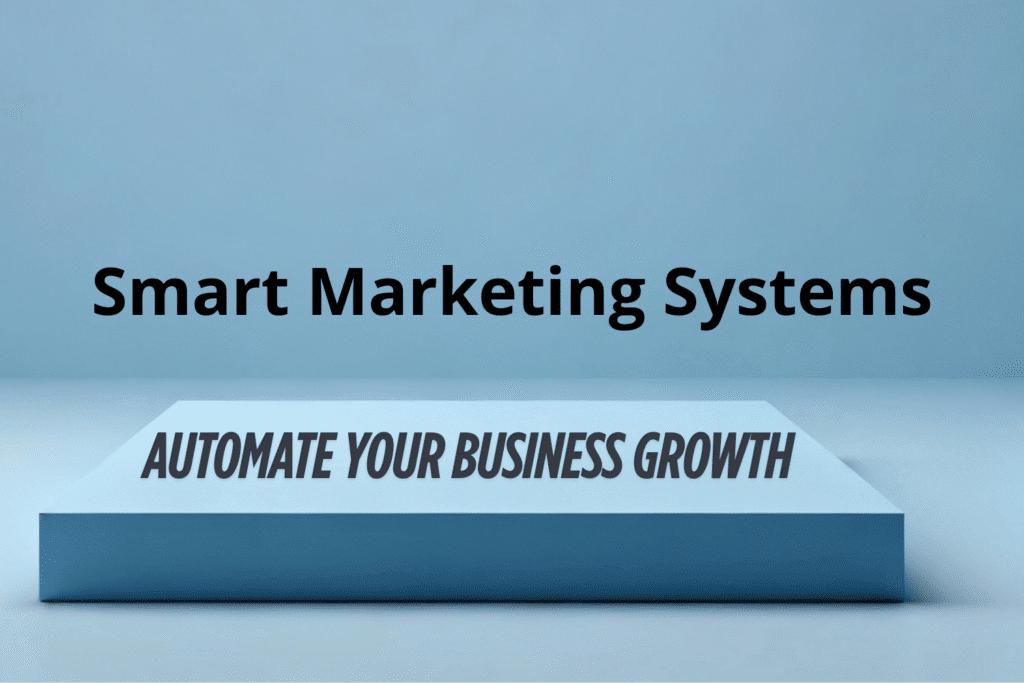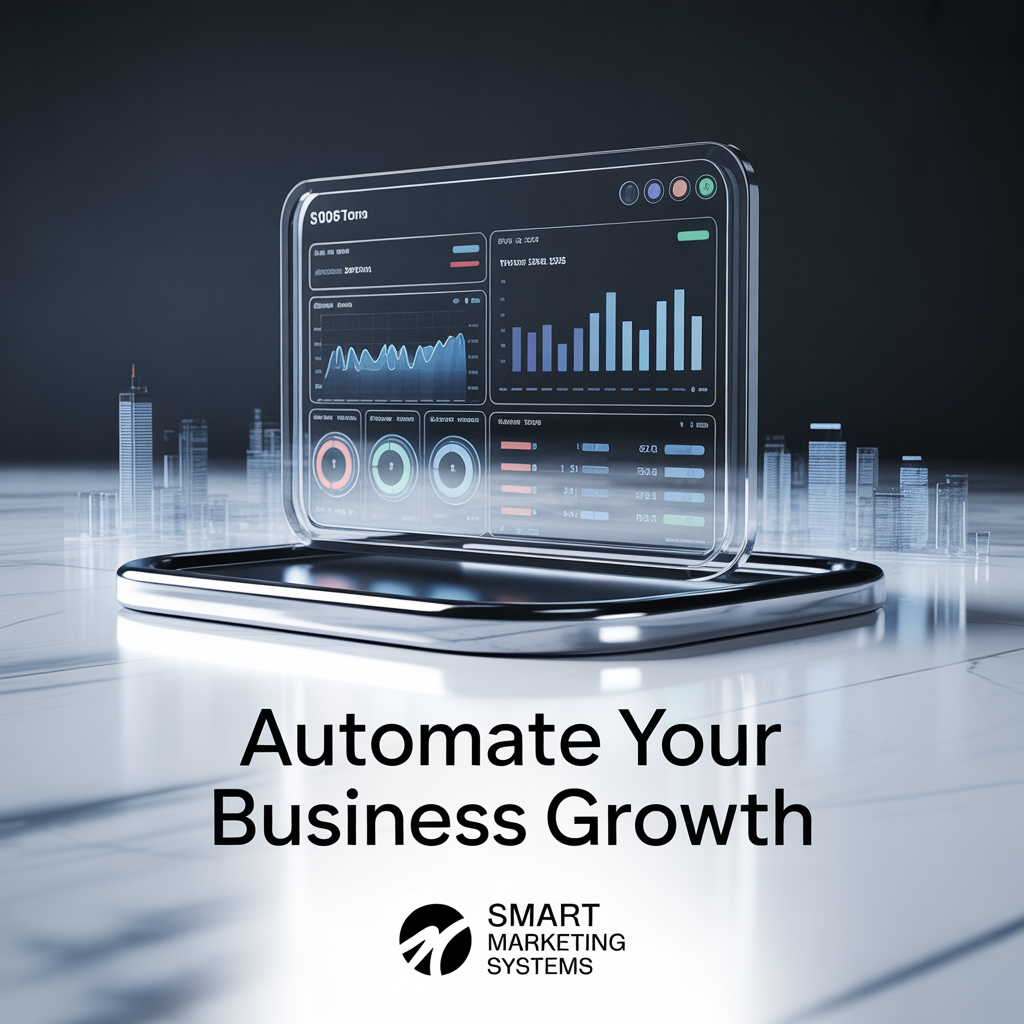
Smart Marketing Systems: Automate Your Business Growth are becoming essential in today’s competitive business landscape. To stay ahead, companies must streamline their marketing efforts, and these systems provide the perfect solution. By leveraging advanced marketing automation technologies, smart marketing systems empower businesses to save time, optimize campaigns, and accelerate growth.
Smart Marketing Systems: Automate Your Business Growth help organizations optimize strategies and boost efficiency. These systems drive revenue by automating routine tasks. Businesses can then focus on high-value activities that fuel growth. With effective automation, companies can personalize customer interactions and improve experiences. This approach also increases engagement and ultimately drives more conversions.
Key Takeaways
- Smart marketing systems enable businesses to automate growth.
- Marketing automation technologies optimize marketing strategies.
- Automating routine tasks improves efficiency and drives revenue.
- Personalized customer interactions enhance customer experiences.
- Effective marketing automation drives conversions and business growth.
The Power of Smart Marketing Systems
In today’s fast-paced business landscape, smart marketing systems are transforming how companies handle customer engagement and sales. Additionally, advanced technologies allow businesses to streamline marketing efforts. As a result, campaigns become more efficient and effective.
Defining Modern Marketing Automation
Modern marketing automation uses software to automate repetitive tasks, such as email campaigns, social media posting, and lead generation. Consequently, businesses can focus on higher-value strategic activities.
Moreover, marketing automation platforms provide tools to personalize customer interactions. Therefore, engagement and conversion rates improve significantly.
By automating routine tasks, marketing teams gain more time for creative and strategic initiatives. This enables innovation and growth. Integration with automation tools also allows companies to respond quickly to customer inquiries, fostering a more dynamic marketing strategy.
How Automation Transforms Business Operations
Marketing automation improves business operations by enhancing efficiency and reducing manual labor. Automating sales processes allows teams to send follow-ups, track interactions, and analyze sales data more effectively. Furthermore, this leads to better performance and customer service.
In addition, marketing automation provides valuable insights into customer behavior. Businesses can tailor marketing efforts to specific audience segments. By analyzing customer data, companies can create campaigns that resonate, ultimately driving growth.
Measuring the Business Impact of Marketing Automation
Tracking the impact of marketing automation is crucial. Its effectiveness appears in streamlined processes, improved customer engagement, and increased sales. To fully understand its potential, businesses should focus on key metrics and performance indicators.
Key Performance Indicators (KPIs) for Automation Success
Businesses measure success with several KPIs:
- Conversion Rate: Percentage of leads that become customers.
- Lead Generation: Number of new leads from automated campaigns.
- Email Open and Click-Through Rates: Effectiveness of email marketing.
- Customer Retention: Ability to maintain customer relationships.
In addition, monitoring KPIs allows refinement of marketing automation strategies. For example, analyzing email open rates helps create more engaging and targeted campaigns.
Real-World Success Stories: Automation in Action
Several businesses have achieved measurable results with marketing automation. For instance, an e-commerce brand automated email marketing, increasing sales by 25% in six months. Similarly, a software company personalized customer interactions, improving retention by 30%.

| Company | Automation Strategy | Result |
|---|---|---|
| E-commerce Brand | Email Marketing Automation | 25% Increase in Sales |
| Software Company | Personalized Customer Interactions | 30% Improvement in Retention |
Consequently, these examples highlight the potential of automation to drive growth and improve performance. Using the right metrics helps unlock new opportunities for automated growth.
Essential Components of Effective Marketing Systems
CRM Integration: The Foundation
CRM integration ensures customer data is synchronized across platforms. This enables a unified view of customer interactions. With CRM systems like Salesforce or HubSpot, businesses can personalize marketing efforts and improve service.
Content Management and Delivery Systems
Content management systems (CMS) manage and deliver content across channels. For example, tools like WordPress or Adobe Experience Manager streamline delivery, ensuring the right content reaches the right audience at the right time.
Analytics Platforms for Data-Driven Decisions
Analytics platforms provide insights into customer behavior and campaign performance. As a result, marketers can make data-driven decisions and optimize strategies for higher ROI.
Tracking Customer Behavior Patterns
Analyzing behavior patterns helps identify trends and preferences. In addition, tools like Google Analytics track interactions and provide actionable insights.
Conversion Attribution Models
Attribution models reveal which channels drive conversions. By using last-click or linear attribution, businesses can allocate budgets more effectively and maximize ROI.
Automating Leads, Sales & Growth
Lead Generation Automation
Automated lead generation captures, qualifies, and nurtures leads efficiently.
Lead Scoring and Qualification: Implement scoring to rank leads based on engagement and demographics. This ensures sales teams focus on the most promising leads.
Automated Nurturing Sequences: Send targeted communications based on lead behavior. Consequently, trust builds, and leads move through the funnel faster.
Sales Pipeline Automation
Automating the sales pipeline reduces errors and boosts conversion rates. Techniques include:
- Follow-up emails and reminders
- Analytics to predict sales trends
- CRM tracking of interactions
As a result, personalized experiences convert more leads into customers.
Growth Metrics and Performance Tracking
Track conversion rates, sales cycle lengths, and acquisition costs to measure success. Additionally, analyzing metrics allows optimization of automation strategies.
Multi-Channel Marketing Automation
Email Marketing Workflows and Triggers
Automated workflows send timely, relevant messages. For example, welcome emails, abandoned cart reminders, and personalized offers improve engagement and sales.
Social Media Content and Engagement Automation
Automation ensures consistent posting and faster responses. In addition, scheduling tools and analytics allow strategy adjustments for better performance.
Website Personalization and Conversion Optimization
Tailor experiences based on user behavior and preferences. Personalized content, offers, and dynamic CTAs improve engagement and conversions.
Mapping and Automating the Customer Journey
Identifying Critical Touchpoints
Identify touchpoints where automation adds value, such as website visits, social interactions, or post-purchase follow-ups. This ensures processes are streamlined and customer satisfaction improves.
Creating Personalized Experiences at Scale
Use data and analytics to deliver personalized experiences. Consequently, engagement increases, and conversions improve.
Behavioral Triggers and Response Systems
Automate responses to customer actions, such as email campaigns or personalized offers. For example, cart abandonment emails recover potential lost sales.
Re-engagement Campaigns
Target dormant customers with personalized campaigns. As a result, interest is reignited, boosting retention and sales.
Overcoming Marketing Automation Challenges
Implementation Pitfalls
Avoid inadequate planning, insufficient training, and poor system integration. Instead, invest in planning, training, and careful implementation.
Data Quality and Integration Issues
Ensure data is accurate, current, and integrated. Additionally, validation processes and integration tools unify sources.
Balancing Automation with Human Touch
Maintain human interaction in automated processes. This ensures personalization and effective customer engagement.
Emerging Trends in Smart Marketing Automation
AI and Machine Learning Applications
AI and ML enable advanced data analysis, personalization, and campaign optimization. For instance, predictive lead scoring and automated chatbots improve engagement.
Predictive Analytics for Customer Behavior
Forecast customer behavior using historical data. Consequently, businesses can anticipate needs, reduce churn, and improve retention.
Voice, AR, and Conversational Automation
Voice search and AR provide immersive customer experiences. In addition, these technologies create new engagement opportunities.

Conclusion: Accelerating Growth Through Automation
Smart marketing systems streamline operations, enhance experiences, and drive growth. By integrating automation, companies can optimize leads, sales pipelines, and engagement. Ultimately, automation enables scalable growth and long-term success.
FAQ
Q: What is marketing automation, and how can it benefit my business?
A: It automates repetitive tasks like email, lead generation, and social media. As a result, businesses save time, increase efficiency, and drive growth.
Q: How do I measure marketing automation success?
A: Track KPIs such as conversion rates, lead generation, and engagement. Then, analyze metrics to optimize campaigns.
Q: What challenges exist with marketing automation, and how can I overcome them?
A: Challenges include implementation pitfalls, data quality issues, and balancing automation with human touch. To overcome these, invest in training, maintain accurate data, and balance automation with personal interaction.
Q: How do I integrate marketing automation with my CRM?
A: Use APIs, import/export tools, or native integrations to connect systems. This ensures streamlined sales and marketing processes.
Q: What emerging trends should I follow?
A: AI, machine learning, predictive analytics, and AR/voice technologies are transforming automation.
Q: How does automation create personalized experiences?
A: Automation leverages data to deliver targeted campaigns and maps customer journeys. Consequently, experiences are personalized at scale.